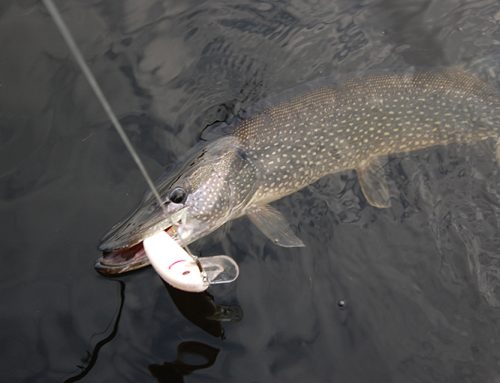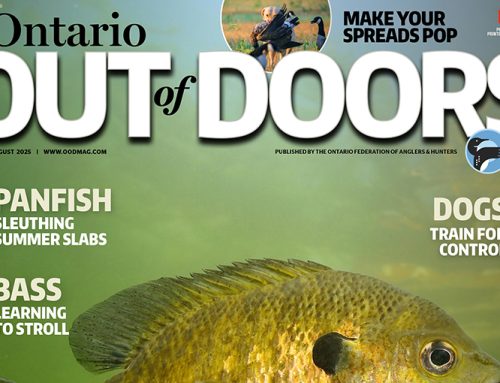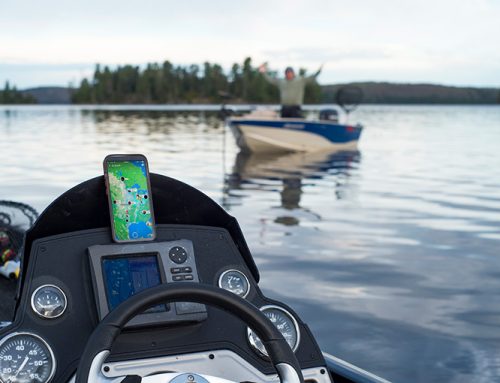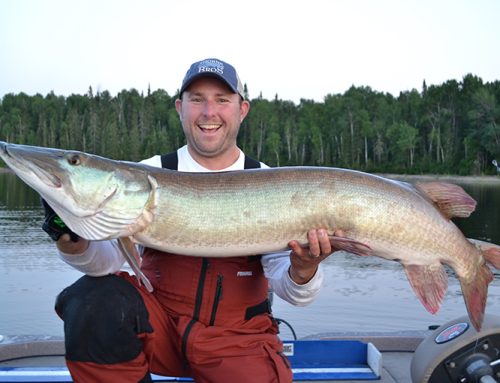
Ice fishing has come a long way, baby! When I look back on some of my first memories — watching gads, catching fishstick-sized perch and huddling close to a fire in the 1980s — it’s incredible how much hard water tech and tactics have evolved.
Things really started taking off a couple decades ago. A boom in quality and availability of reasonably priced gear helped participation grow. Modern ice fishing had arrived, and if there was a unifying, rallying cry resounding across the ice belt it was — “Mobility!”
Drill, drill, drill. Move, move, move.
So it went, and so it continues for many anglers. Yet, ice fishing is evolving. For instance, mobility remains important, but time on the water combined with cutting-edge technology have shown moving for movement’s sake is futile — or worse, counterproductive.
This is just one example capturing the “fish smarter, not harder” mindset shared by many anglers today. With this concept in mind, what follows are strategies for increasing angling success on the ice and minimizing grunt work.
Cover water…sitting down
Before even putting boots to ice, anglers can find great ice fishing spots in autumn scouting water from a boat. Learn where walleye, pike, crappie, perch, whitefish, and other species hang out in November, and you’ll likely find fish around these same areas come first ice.
Granted, this practice isn’t new, given surveying water has long been more efficient from a boat than on ice. It’s become even easier with the ability to create personalized fishing maps using the latest electronics.
Recently, I’ve been making maps with one-foot contours with a Garmin Echomap Ultra 106sv. This has revealed small reefs, rock ridges on flats, and other gems where fish lurk, which are not shown on commercially available digital lake contour maps. The benefits of open-water mapping are not lost on Adam Pugh, ice-fishing guide and owner/operator of Lake Temagami’s Loon Lodge (loonlodge.com), who offers guided day trips as well as hard huts and on-ice bungalow rentals.
“With the Humminbird AutoChart feature, I can do groundwork in summertime, and these days I’m dropping more waypoints applicable to ice fishing than ever in the boat. Putting the boat sonar on the dash of my snowmobile, I can drive until I’m drilling and fishing the exact contour I want. I’m also seeing more anglers visiting Temagami to do mapping in open-water to get ready for ice fishing trips.”
Brian Brosdahl, a Minnesota fishing guide and founding father of modern ice fishing, lives on the cutting edge of technology. Back when I ice fished with him in 2014, he had already devised a hard water set-up for Humminbird’s 360 technology (then newly released). He’s been using the latest version ever since.
In unfamiliar areas, 360 gives a bird’s-eye view of the underwater terrain. It helps Brosdahl find the all-important bottom transitions and other structure where fish congregate 365 days a year. He marks these spots on the boat, bringing the data and tech on the ice come winter.
Appreciating not every angler owns the latest in fishing electronics, Brosdahl recommends some online searches. Speaking about walleye, he explained his approach. “You don’t have to go all the way out to the reef to catch walleye. The walleyes, typically, are closer to shore because white-fish spawn in fall shallow,” he said. “There are also weedbeds full of shiners and other food…Use LakeMaster maps and Google Earth to look for the deepest water closest to shore and for shoreline connected points. Of course, other important ingredients to find are weeds and rock.”
Schedule for success
While you can scout good areas from the couch, you can’t catch them there. This said, there is value in being strategic about the days and times you get off your posterior and hit the ice.
“For a hard-hut vacation, the best thing to do is book huts or an ice bungalow around the best moon phases of the month because you’re going to stay in one place the whole time,” Pugh said. “You’re staying still for a prolonged period, so be there during the time fish are going to be most active.”
Pugh also considers solunar data for run-and- gun guided trips for lake trout. This means fishing hard during the best week of the month, as well as being on the ice during the optimal a.m./p.m. minor and major peaks.
“If we’re fishing lake trout and there’s a major at 8 a.m., it’s almost like clockwork. That’s when the bites come,” Pugh said.
“Fishing smarter might mean only fishing walleye when the sun’s at the top of the trees,” Pugh said. “On lakes that don’t have as many options to fish for other species during the day like Temagami does for lake trout, once you have the walleye dialed in it can make sense to only fish that one- and-a-half-hour window at prime time and that’s it. This is when a hard hut can be a big advantage.”
Drill like a guide
These days for Brosdahl, the fewer holes drilled, the better. To reduces unnecessary “search” holes he references waypoint and lake maps. He also often traces the area from his snow-machine, leaving a set of tracks down over key features.
“If you drill too much you can shut the whole area down and ruin the bite,” he said. “With today’s technology, you don’t have to drill close in most situations…Drill the span of the area with a sled, then fine tune it after using electronics like 360 and MegaLive.”
Brosdahl’s drilling is clandestine, too, and for good reason. As an elite ice angler, he finds fish better than most. This proficiency brings a responsibility of not broadcasting the location of fish he’s found, especially on small, fragile fisheries, by way of leaving dozens of ice holes mapping out the area. If you’ve ever known a good fishing spot become a community hole unable to sustain increasing angling pressure, you know where Bro is coming from. I certainly do.
“I drill in a defensive way so less people can see me, and my favourite time to look for new spots is when it’s snowing because the snow conceals things, and I always kick in holes,” he said.
When to stay put and fine tune
With an array of cold- to warm-water fish swimming in various water systems, there’s not a one- size-fits-all approach to ice fishing. This includes strategies surrounding mobility. As Pugh notes, there are times for both running-and-gunning as well as staying put in an ice house.
The middle ground between these extremes is what Brosdahl’s getting at when he refers to fine-tuning position within an area. Keep in mind, he is talking crappie, perch, bluegills, and daytime walleye. These species move a lot less compared to lake trout, which is why Pugh’s run-and-gun approach is effective. Being overly mobile can backfire when chasing panfish, he noted.
“I see it all the time,” Brosdahl said. “People drill, find fish, then keep drilling and go past them.”
In shore, when an area holds fish, don’t be in a hurry to move on. Dissect the area to find better spots and more willing biters. Scan around for spots where fish either loiter or use as travel routes.
“Humminbird 360 really lets you hone-in on a structure,” Brosdahl said. “One of the best spots I found last year was a little pod of scattered boulders on a flat. I didn’t see fish at first, but it looked amazing, so I got over it and jigged. It held magnum perch and nice eater walleye.”
In my experience, fine tuning position often pays off. One memorable outing was working back and forth across a shallow flat at late ice for giant crappie and perch and seeing Steve Barnett land a 14-and-a-half-inch crappie, the season’s best for our crew.
The approach also works when my children and I fish together. Running-and-gunning isn’t logistically possible for us, but hole-hopping around a productive area is right in the wheelhouse of my two energetic offspring and keeps boredom at bay, for a while, anyway.
Lighten up
Earlier I mentioned the surge in ice fishing gear on the market. Many folks are carrying more than they likely need.
Carrying a lot of stuff can bog you down. Keep the essentials, of course, but culling unnecessary stuff improves on-ice mobility, especially when fine-tuning location within an area. Going light is one of the smartest things I’ve learned to do on the ice.
Land more fish
Getting a fish up a hole is a high-risk maneuver and the bottom of the ice is where a lot of fish come unbuttoned. Pugh’s found he gets more lake trout on the ice when using lipless crankbaits, thanks to a simple modification. He replaces the front hook with a VMC Bladed Hybrid Treble.
“It’s hard to keep a big laker that’s lightly hooked from getting away when it starts thrashing at the bottom of the hole,” Pugh said. “Adding that hook really seems to help lake trout line up the bait. Now 90% of the fish are getting hooked in the top of the mouth and we’re landing more fish.”
Using clear fluorocarbon will help you land more fish on the ice, Brosdahl said. Compared to nylon lines, fluorocarbon is denser and faster sinking than mono, which is key in the vertical game of ice fishing. Fluoro, being nearly invisible underwater, doesn’t hurt either. Brosdahl uses fluorocarbon for its abrasion resistance. Its durability is going to stand up to the abuse when a big walleye goes berserk and drags and saws the line across sharp, craggy ice at the bottom of the hole. He frequently uses straight fluorocarbon, but a fluoro leader tied to braid also gets the thumbs up when fishing deep and freeze-up isn’t an issue.
It isn’t all about analytics
Each passing winter, I become less interested in grinding it out on the ice. Like Brosdahl and Pugh, I’m trying to be more strategic about when to fish, the areas visited, and tactics used. However, there’s a balance here, too. One must not lose sight of benefits gained from spending time in the great out-of-doors with family and friends. After all, there are many reasons an ice fishing trip can be considered a success, many simply about the experience in and of itself.
Originally published in the Jan.-Feb. 2023 issue of Ontario OUT of DOORS magazine






Leave A Comment